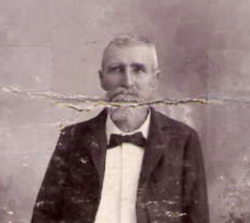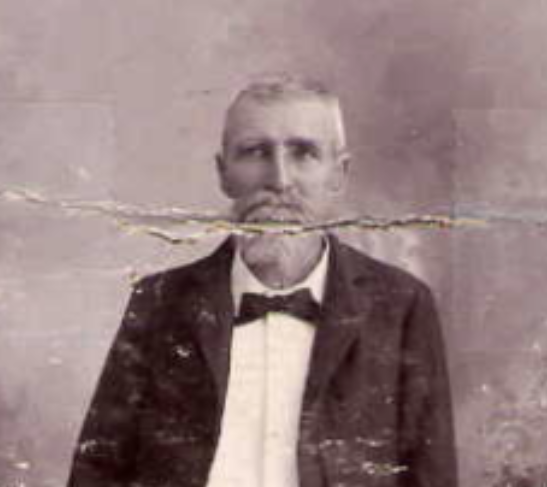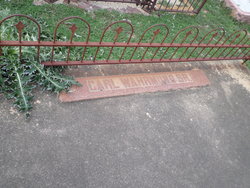KARL AUGUST WAHRMUND, GILLESPIE COUNTY PIONEER
KARL AUGUST WAHRMUND was born in Germany March 23, 1832, and when he was thirteen years old he came to Texas with his parents in December 1845, his parents settling at Fredericksburg in 1846, being among the first pioneers to settle there. They had to live in a tent until they could get a log cabin built. When Karl was sixteen years old he took his gun one morning and went out hunting. As he passes a neighbor's house he heard a woman calling for help . Going into the house to investigate, he found the woman sick in bed with the cholera, and her husband lying beside her dead. He hastened back home and secured help, and with his father and several neighbors went back in an ox-cart and helped to gather all of the persons there who had died with the dreadful plague and buried them all in one big grave, while the women cared for the sick woman and others who were ill. The woman lived two more days and she died.
During this period the Indians were still friendly and gave these white people all the honey and meat they could eat. Game was plentiful in those days, and one morning Karl killed a big buffalo bull on the spot where the Fredericksburg High School building now stands.
On one occasion, when Mr. Wahrmund was still a boy, and the Indians were still friendly with the whites, he went to visit an Indian camp on the market square. Here he found about twenty scalps hanging on a buckskin string in front of an old chief 's wigwam. As soon as the chief saw him looking at those scalps he came out and pushed him aside and took the scalps away. The scalps were not from the heads of white people, however, but were of other Indians and Mexicans.
On June 26, 1851, Karl August Wahrmund was married to Miss Dora Juenke when he was only ninteen years old. He and his bride moved to Bear Creek and settled on a little farm . By this time the Indians had become hostile, and were dangerous, and the white settlers had to be constantly on the look-out for them. One day Mr. Wahrmund sent Henry Cram, a man who was working for him, to bring in the horses Mr. Cram did not bring them in, so, hearing the horse bell about half mile away, Mr. Wahrmund decided to go and bring them in himself, leaving his gun at home. When he came to the horses he saw a man trying to loosen the hobbles, and thinking it was Cram, he said : "Heinrich, bist du das.' ' But it was an Indian who was taking the hobbles off the horse, and as he jumped up several other Indians appeared and gave chase. Mr. Wahrmund was a good runner and made it for home in quick time, the Indians following, but he outran them, and when he came to his yard fence he jumped over it and fell unconscious in the yard.
The Indians then left without taking the horses. Mrs. Wahrmund, seeing her husband fall, thought the Indians had shot him and ran to help him. She managed to get him into the house, and though badly scared, she was rejoicing to find that he had not been injured. It was several hours before he regained consciousness, and as it was then dark he had to wait until morning came to get help. The next day search was made for the Indians but they were gone. Cram had discovered the presence of the Indians and as he was unarmed, he concealed himself and waited until after dark to return home.
On another occasion Mr. Wahrmund went off on a trip, leaving his wife and two small children at home. The children were out playing, when suddenly they ran screaming to the house, and Mrs. Wahrmund saw an Indian coming toward the house, striking his breast and saying "Ha, ha, ha." But she did not know what he meant, so she grabbed her two children and ran to the home of her brother-in-law, Emil Wahrmund, who lived about a half a mile away. When she arrived there and reported the presence of the Indian, her brother-in-law notified the neighbors and went to investigate. They found the Indian and learned that he had been wounded in a fight near Comfort a few days before, while with a band of redskins on a horse-stealing raid. They captured him and took him to Fredericksburg and turned him over to the authorities . Court was held and they decided that the best thing to do with the Indian was to kill him, so he was taken to Spindle Top, a hill about a half mile west of the village, and hanged to a live oak tree, and his body filled with shot. When Karl Wahrmund returned from his trip and learned how they had treated the wounded Indian, he was very angry with the men who had put the Indian to death, telling them they were cowards, and would certainly suffer for what they had done . He told them if they had taken the Indian and nursed him until he recovered from his wounds and then sent him back to his tribe the Indians would have always been kind to the settlers there . When the execution took place it is said that the Indian said not a word, only his
face became pale when they tied the rope around his neck and held their guns on him.
One rainy day, while Mr. Wahrmund was out hunting, he met an Indian face to face, neither one seeing the other until they met . On account of the rain the Indian had a buckskin wrap around his gun to keep the powder dry, and therefore could not get it in readiness to shoot. Evidently realizing that he was at the white man's mercy, he dropped the gun and held up his hands. Mr. Wahrmund picked up the gun, fired the load out of it, handed it to the Indian, and motioned for him to turn and leave. Before leaving he made a polite bow and spoke a few words in the Indian language, perhaps thanking the white man for sparing his life.
Later on a company of minute men was organized, with Frank von Stunke as captain, to protect the settlement from Indian raids . When the Civil War came on this company served in the Confederate army under Captain Stunke, and Mr. Wahrmund was first sergeant of the company. For some time Mr. Wahrmund worked for the United States government, taking food and clothing to the Indians on the reservation and watching for captive white children. If they found any of these captives they traded the Indians food and clothing for them and returned them to their people.
One time when they were among the Indians they noticed seven Indians keeping close watch over a big bundle of hides. Two Indians were always sitting on the bundle; when they got up, two other Indians would sit down on it. Mr. Wahrmund and the men with him decided to investigate, and they found a little white girl wrapped in the bundle. They had to do a lot of talking and trading before they could get the child, but they finally traded for her, and carried her to San Antonio, and she was restored to her people.
After the Civil War Mr. Wahrmund moved his family to Tivydale, where they settled on a farm. On February 27, 1911, he died at the age of 79 years . His wife died May 18, 1919. They are survived by the following children : Louis Wahrmund of Tivydale; Frank Wahrmund of Petersburg ; Christian Wahrmund of Doss ; Theodore Wahrmund of Fredericksburg ; Mrs. A. H. Pohl of Little Rock, Arkansas ; Mrs. Wm . Althaus of Gold, Texas ; Mrs. Simon Eckstein and Mrs. Ad. Hartman of Kerrville ; Mrs. Joe Kraus of Llano, Mrs. G. Williams of Blanco, and Mrs. Emil Heimann, Sr., of Fredericksburg.
KARL AUGUST WAHRMUND, GILLESPIE COUNTY PIONEER
KARL AUGUST WAHRMUND was born in Germany March 23, 1832, and when he was thirteen years old he came to Texas with his parents in December 1845, his parents settling at Fredericksburg in 1846, being among the first pioneers to settle there. They had to live in a tent until they could get a log cabin built. When Karl was sixteen years old he took his gun one morning and went out hunting. As he passes a neighbor's house he heard a woman calling for help . Going into the house to investigate, he found the woman sick in bed with the cholera, and her husband lying beside her dead. He hastened back home and secured help, and with his father and several neighbors went back in an ox-cart and helped to gather all of the persons there who had died with the dreadful plague and buried them all in one big grave, while the women cared for the sick woman and others who were ill. The woman lived two more days and she died.
During this period the Indians were still friendly and gave these white people all the honey and meat they could eat. Game was plentiful in those days, and one morning Karl killed a big buffalo bull on the spot where the Fredericksburg High School building now stands.
On one occasion, when Mr. Wahrmund was still a boy, and the Indians were still friendly with the whites, he went to visit an Indian camp on the market square. Here he found about twenty scalps hanging on a buckskin string in front of an old chief 's wigwam. As soon as the chief saw him looking at those scalps he came out and pushed him aside and took the scalps away. The scalps were not from the heads of white people, however, but were of other Indians and Mexicans.
On June 26, 1851, Karl August Wahrmund was married to Miss Dora Juenke when he was only ninteen years old. He and his bride moved to Bear Creek and settled on a little farm . By this time the Indians had become hostile, and were dangerous, and the white settlers had to be constantly on the look-out for them. One day Mr. Wahrmund sent Henry Cram, a man who was working for him, to bring in the horses Mr. Cram did not bring them in, so, hearing the horse bell about half mile away, Mr. Wahrmund decided to go and bring them in himself, leaving his gun at home. When he came to the horses he saw a man trying to loosen the hobbles, and thinking it was Cram, he said : "Heinrich, bist du das.' ' But it was an Indian who was taking the hobbles off the horse, and as he jumped up several other Indians appeared and gave chase. Mr. Wahrmund was a good runner and made it for home in quick time, the Indians following, but he outran them, and when he came to his yard fence he jumped over it and fell unconscious in the yard.
The Indians then left without taking the horses. Mrs. Wahrmund, seeing her husband fall, thought the Indians had shot him and ran to help him. She managed to get him into the house, and though badly scared, she was rejoicing to find that he had not been injured. It was several hours before he regained consciousness, and as it was then dark he had to wait until morning came to get help. The next day search was made for the Indians but they were gone. Cram had discovered the presence of the Indians and as he was unarmed, he concealed himself and waited until after dark to return home.
On another occasion Mr. Wahrmund went off on a trip, leaving his wife and two small children at home. The children were out playing, when suddenly they ran screaming to the house, and Mrs. Wahrmund saw an Indian coming toward the house, striking his breast and saying "Ha, ha, ha." But she did not know what he meant, so she grabbed her two children and ran to the home of her brother-in-law, Emil Wahrmund, who lived about a half a mile away. When she arrived there and reported the presence of the Indian, her brother-in-law notified the neighbors and went to investigate. They found the Indian and learned that he had been wounded in a fight near Comfort a few days before, while with a band of redskins on a horse-stealing raid. They captured him and took him to Fredericksburg and turned him over to the authorities . Court was held and they decided that the best thing to do with the Indian was to kill him, so he was taken to Spindle Top, a hill about a half mile west of the village, and hanged to a live oak tree, and his body filled with shot. When Karl Wahrmund returned from his trip and learned how they had treated the wounded Indian, he was very angry with the men who had put the Indian to death, telling them they were cowards, and would certainly suffer for what they had done . He told them if they had taken the Indian and nursed him until he recovered from his wounds and then sent him back to his tribe the Indians would have always been kind to the settlers there . When the execution took place it is said that the Indian said not a word, only his
face became pale when they tied the rope around his neck and held their guns on him.
One rainy day, while Mr. Wahrmund was out hunting, he met an Indian face to face, neither one seeing the other until they met . On account of the rain the Indian had a buckskin wrap around his gun to keep the powder dry, and therefore could not get it in readiness to shoot. Evidently realizing that he was at the white man's mercy, he dropped the gun and held up his hands. Mr. Wahrmund picked up the gun, fired the load out of it, handed it to the Indian, and motioned for him to turn and leave. Before leaving he made a polite bow and spoke a few words in the Indian language, perhaps thanking the white man for sparing his life.
Later on a company of minute men was organized, with Frank von Stunke as captain, to protect the settlement from Indian raids . When the Civil War came on this company served in the Confederate army under Captain Stunke, and Mr. Wahrmund was first sergeant of the company. For some time Mr. Wahrmund worked for the United States government, taking food and clothing to the Indians on the reservation and watching for captive white children. If they found any of these captives they traded the Indians food and clothing for them and returned them to their people.
One time when they were among the Indians they noticed seven Indians keeping close watch over a big bundle of hides. Two Indians were always sitting on the bundle; when they got up, two other Indians would sit down on it. Mr. Wahrmund and the men with him decided to investigate, and they found a little white girl wrapped in the bundle. They had to do a lot of talking and trading before they could get the child, but they finally traded for her, and carried her to San Antonio, and she was restored to her people.
After the Civil War Mr. Wahrmund moved his family to Tivydale, where they settled on a farm. On February 27, 1911, he died at the age of 79 years . His wife died May 18, 1919. They are survived by the following children : Louis Wahrmund of Tivydale; Frank Wahrmund of Petersburg ; Christian Wahrmund of Doss ; Theodore Wahrmund of Fredericksburg ; Mrs. A. H. Pohl of Little Rock, Arkansas ; Mrs. Wm . Althaus of Gold, Texas ; Mrs. Simon Eckstein and Mrs. Ad. Hartman of Kerrville ; Mrs. Joe Kraus of Llano, Mrs. G. Williams of Blanco, and Mrs. Emil Heimann, Sr., of Fredericksburg.
Family Members
-
![]()
Amelia Wahrmund Pohl
1851–1933
-
![]()
Louis Wahrmund
1853–1933
-
![]()
Susanna Dorothea "Dora" Wahrmund Althaus
1856–1938
-
![]()
Franz "Frank" Wahrmund Sr
1859–1937
-
![]()
Caroline "Lena" Wahrmund Eckstein
1862–1943
-
![]()
Auguste Wahrmund Kraus
1865–1948
-
![]()
Bertha Wahrmund Willms
1866–1940
-
![]()
Emilie Wahrmund Heimann
1869–1952
-
![]()
Christian Wahrmund II
1871–1959
-
![]()
Theodore Wahrmund
1873–1965
-
![]()
Rosa Wahrmund Hartmann
1875–1937
Sponsored by Ancestry
Advertisement
Advertisement





















